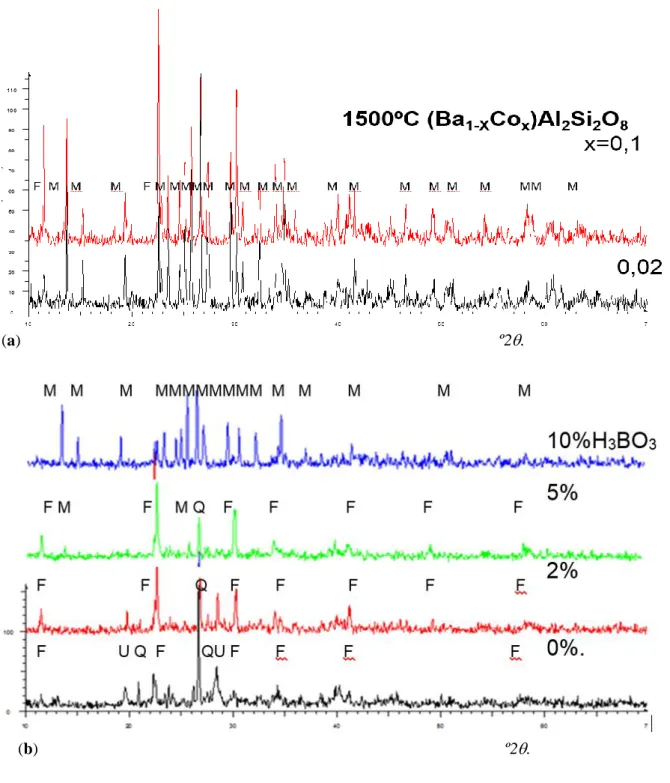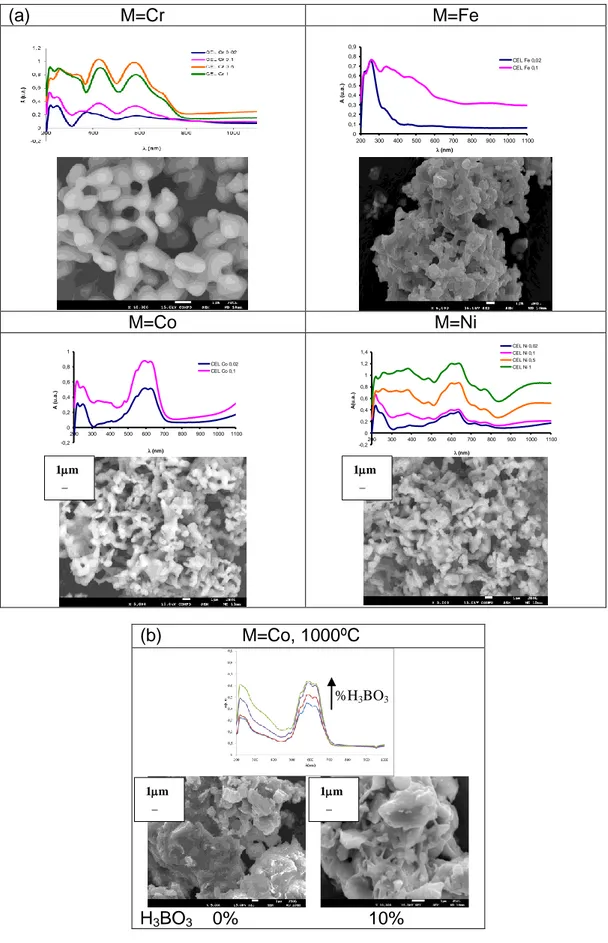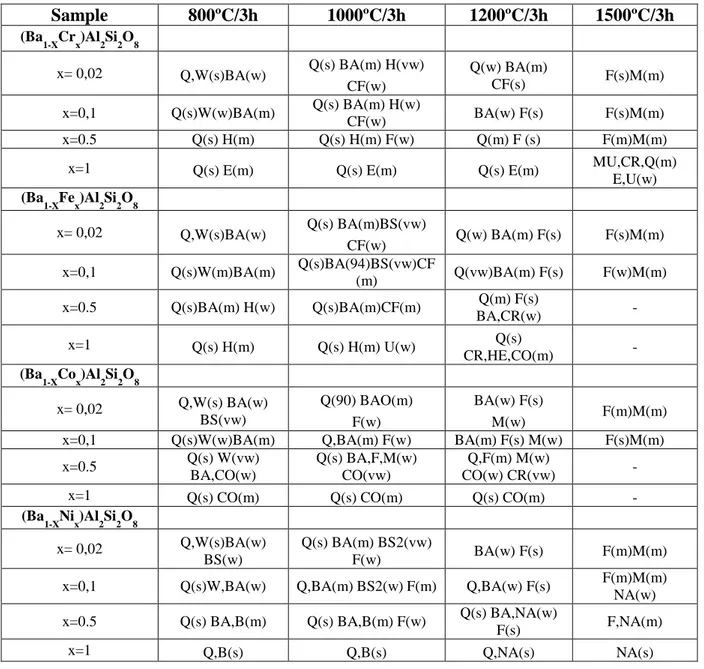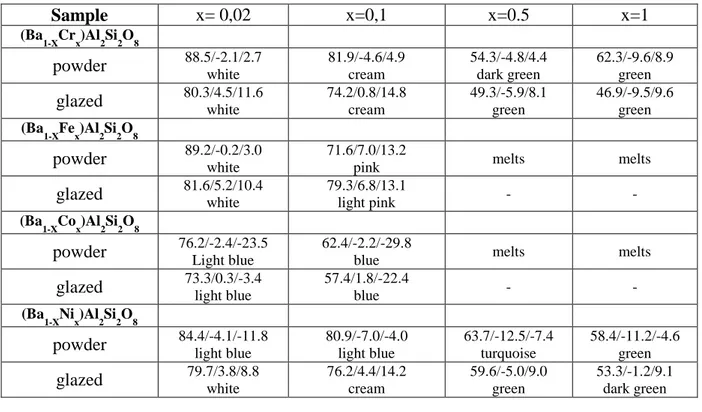Ceramization of heavy metals in (Ba1−X Mx)Al2Si2O8 celsian solidsolutions and recycling as pigments
Texto completo
(2) Highlights (for review). Highlights. - Heavy metals have been immobilized in celsian (Ba1-XMx)Al2Si2O8 solid solutions. - Borates have been used as mineralizers obtaining monophasic celsian at 1000ºC/3h. - Solid solutions act as ceramic pigments in ceramic glazes. - Solid solutions have been evaluated by leachate test for its landfill disposal..
(3) *Manuscript. 1 2 3 4 5 6 7 8 9 10 11 12 13 14 15 16 17 18 19 20 21 22 23 24 25 26 27 28 29 30 31 32 33 34 35 36 37 38 39 40 41 42 43 44 45 46 47 48 49 50 51 52 53 54 55 56 57 58 59 60 61 62 63 64 65. CERAMIZATION IN (Ba1-XMx)Al2Si2O8 CELSIAN SOLID SOLUTIONS OF HEAVY METALS AND RECYCLING AS PIGMENTS C. Gargori, S. Cerro, N. Fas, M. LLusar, G. Monrós Dpt. Of Inorganic and Organic Chemistry, Jaume I University, Castellon (Spain) Abstract. Ceramization of several heavy metals such as M=Cr, Fe, Co and Ni in celsian lattice has been studied by sintering up to 1500ºC of its oxides with BaCO3, Al(OH)3 and SiO2 in order to obtain (Ba1-XMx)Al2Si2O8 solid solutions. Cr3+ enters in solid solution forming anionic vacancies up to x=0.5 (both celsian and hexacelsian coexists), Fe3+ and Co2+ only up to x=0.1 (both celsian and hexacelsian coexists) and melts at higher x values, Ni only forms solid solution at low x=0.02 coexisting hexacelsian and celsian, at higher x crystallizes NiAl2O4 spinel. But using forming glasses mineralizers such as borates increase the reactivity and monophasic celsian is obtained in the case of Co-celsian solid solution, adding 10wt% of glass forming agent at only 1000ºC/3h of sintering temperature. Powders have been reused as ceramic pigments and leachate test is performed in order to classify the resulting solid solution in order to its landfill disposal (Council Directive 1999/31/EC on the waste landfill). Key words: Heavy metals, Solid solution, Celsian, Ceramic pigment. 1. Introduction. Heavy metals are naturally occurring elements that have a high atomic weight and a density at least 5 g/l, their toxicity depends on several factors including the dose, route of exposure, and chemical species, there has been an increasing ecological and global public health concern associated with environmental contamination by these metals [1]. For an effective immobilization of wastes by sintering (ceramization), ceramic oxide materials such as perovskite (CaTiO3), zirconolite CaZrTi207, hollandite (Bal.23A12.46Ti5.54O16), pyrochlore (LnzZr207 and Ln2Ti207, Ln = rare earth metals), NASICON (Nal1+xZr2P3-xSixO12) and sphene (CaTiSiO5), have gained tremendous interest in the eighties because of their application as the geological medium for the immobilization of radioactive wastes due to the stacking of the metal-oxygen polyhedra in their structure results in the formation of cavities and vacant interlayers capable of accommodating a large number of radioactive cations. [2]. With a similar cation distribution to hollandite Bal.23A12.46Ti5.54O16 (monoclinic, point group 2/m, space group I2/m), celsian BaAl2Si2O8 (monoclinic, point group 2/m, space group I2/c), is a feldspar, although its symmetry is somewhat different: the order in the Celsian is simple, each tetrahedron AlO4 is surrounded by four SiO4 tetrahedra and vice versa, the Ba shows an irregular configuration with 10 neighbours equidistant. This disorder induces a low symmetry and increases the kinetic barrier of nucleation, in fact the Celsian has a metastable polymorph, the Hexacelsian or hexagonal celsian composed of a double alternating sheet of tetrahedra (AlSi)O4 [3,4]. In this communication the immobilization of several heavy metals such as M=Cr, Fe, Co, Ni in celsian system has been studied by sintering up to 1500ºC of its oxides with BaCO3, Al(OH)3 and SiO2 in order to obtain (Ba1-XMx)Al2Si2O8 solid solutions. 2. Material and methods. By the solid state conventional method or ceramic method (heat and beat, shake and bake) solid.
(4) 1 2 3 4 5 6 7 8 9 10 11 12 13 14 15 16 17 18 19 20 21 22 23 24 25 26 27 28 29 30 31 32 33 34 35 36 37 38 39 40 41 42 43 44 45 46 47 48 49 50 51 52 53 54 55 56 57 58 59 60 61 62 63 64 65. solutions (Ba1-XMx)Al2Si2O8 x=0.02, 0.1, 0.5, 1.0 and M=Cr, Fe, Co, Ni into celsian lattice has been studied by sintering up to 1500ºC the metal oxides (Cr2O3, Fe2O3, Co3O4 or NiO) with BaCO3, Al(OH)3 and SiO2 (quartz) as precursors in order to immobilize the metals into the celsian crystal lattice. In the ceramic method the precursors were homogenised in a planetary mill in acetone media. When acetone was evaporated the raw powders were successively fired at 800ºC, 1000 ºC, 1200 ºC and 1500 ºC with a soaking time of 3 hours and with free cooling to room temperature. The as-prepared powders were homogenized manually with mortar and pestle The resulting powders were 5 wt% glazed into a conventional ceramic glaze of the CaO-ZnO-SiO2 system for double firing stoneware (1050ºC) in order to characterize its pigmenting properties. Samples were characterized by the following techiques: a) X-Ray Diffraction (XRD) carried out on a Siemens D5000 diffractometer using Cu K radiation, 10-70 º2 range, scan rate 0.02 º2/s, 4 s per step and 40 kV and 20 mA conditions, b) UV-Vis-NIR spectra of fired powder samples and of 5 wt% glazed samples collected using a Jasco V670 spectrometer through diffuse reflectance technique, c) L*a*b* color parameters of glazed samples measured following the CIE-L*a*b* (Commission International de l'Eclairage) colorimetric method (29) using a X-Rite SP60 spectrometer, with standard lighting D65 and 10º observer. On this method, L* is a measure of lightness (100=white, 0=black) and a* and b* of chroma (-a*=green, +a*=red, -b*=blue, +b*=yellow), d) Microstructure characterization of powders was carried out by Scanning Electron Microscopy (SEM), using a Leo-440i microscope supplied by LEYCA. In the case of cobalt solid solution x=0,1, two leachate test were performed: (I) a weight ratio of powder:water=1:5 was stirred a room temperature during 24h simulating the conventional washing procedure of ceramic pigments before its commercialization, and (II) the as dried (a) whased powders with a weight ratio powder:water=1:16 were stirred a room temperature during 24h in order to classify the resulting solid solution for its landfill disposal (Council Directive1999/31/EC on the waste landfill). 3. Results and discussion. XRD evolution of crystalline phases for samples (Ba1-XMx)Al2Si2O8 M=Cr, Fe, Co, Ni with temperature is shown in Table 1. Results indicate that Cr3+ enters in solid solution forming anionic vacancies up to x=0.5 (both celsian and hexacelsian coexists), Fe3+ and Co2+ only up to x=0.1 (both celsian and hexacelsian coexists) and melts at higher x values, Ni only forms solid solution at low x=0.02 coexisting hexacelsian and celsian, at higher x crystallizes NiAl2O4 spinel. In the case of Co the XRD patterns are shown in Figure 1.a. The reactivity of the powders can be increased using forming glasses mineralizers such as borates (boric acid or sodium perborate); in the case of Co-celsian solid solution, monophasic monoclinic celsian is obtained adding 10wt% of glass forming agent at only 1000ºC/3h of sintering temperature as it can be observed in Figure 1.b. Powders have been reused as ceramic pigments and leachate test is performed in order to classify the resulting solid solution in order to its landfill disposal (Council Directive 1999/31/EC on the waste landfill). Table 2 displays the visual colour and CIEL*a*b* colour parameters of powders and 5wt% glazed tablets into a double firing frit (1050ºC). Samples with x=0.02 and 0.1 don’t show colour showing L* values higher than 80 except Co that show light blue colour in x=0.02 and blue colour L*a*b*=57.4/1.8/-22.4 in x=0.1. In x=0.5 and x=1 samples Iron and Cobalt melt, Ni powders show turquoise colour that turns in green colour in the glaze, finally Cr samples produce green coloured powders and green glazed tablets. Figure.
(5) 1 2 3 4 5 6 7 8 9 10 11 12 13 14 15 16 17 18 19 20 21 22 23 24 25 26 27 28 29 30 31 32 33 34 35 36 37 38 39 40 41 42 43 44 45 46 47 48 49 50 51 52 53 54 55 56 57 58 59 60 61 62 63 64 65. 2.a displays the UV-Vis-NIR spectra of glazed samples (of powders fired at 1500ºC) and SEM micrograph of the x=0.1 corresponding powder: Co samples show bands associated to Co(II) in tetrahedral coordination (5), Fe samples show bands associated to Fe(III) in octahedral coordination (6), Cr glazed samples show Cr(III) in octahedral coordination (7) and finally Ni glazed tablets show Ni(II) in octahedral sites (7). Figure 2.b shows the UV-Vis-NIR spectra of M=Co mineralized by progressive addition of acid boric (from 0 to 10 wt%) fired at 1000ºC before leachate I and SEM micrographs of 0% and 10% addition of H3BO3. The UV-Vis-NIR absorption increases with the addition of the mineralizer and the feature of SEM images indicates that sintering of powders is similar in 0% and 10% addition of H3BO3. Table 3 shows the obtained results of leachate tests (I) and (II) for (Ba0,9Co0,1)Al2Si2O8 mineralized by progressive addition of acid boric (from 0 to 10 wt%) fired at 1000ºC. In order to its landfill disposal the leaching limits of the “COUNCIL DECISION of 19 December 2002 establishing criteria and procedures for the acceptance of waste at landfills” (minimum pH=6) and the Spanish “Real Decreto 849/1986 del reglamento del Dominio público Hidráulico” (pH betwenn 5.5-9.5 and boron 10 ppm) has been considered. pH and conductivity were measured with pH-metter and conductimeter (both supplied by Crison) respectively, boron has been measured by azometine optical spectroscopy at 410 nm in a Jasco spectrometer, cobalt was measured by ethyl ether extraction of the blue complex Co(SCN)42– by addition of NH4SCN to the leachates. On leachate II the MicrotoxTM test based on Photobacter phosphoreum (Vibrio fischeri) bioluminiscence inhibition was performed. The results indicate a decrease on the screening measurement for MicrotoxTM test which always is lower than 25% (indicating a EC50 higher tan 3000) and good inertization of cobalt (always over the detection limit by the Co(SCN)42– assay) but the presence of boron increases with mineralizer addition and exceeds the limit of 10 ppm, then although mineralizer increase the reactivity it contravenes environmental criteria. 4. Conclusions. Immobilization of several heavy metals such as M=Cr, Fe, Co and Ni in celsian lattice has been reached by sintering up to 1500ºC of its oxides with BaCO3, Al(OH)3 and SiO2 in order to obtain (Ba1-XMx)Al2Si2O8 solid solutions: up to x=0.5 for Cr3+, Fe3+ and Co2+ only up to x=0.1 and Ni only at x=0.02. Using forming glasses mineralizers, such as borates, increase the reactivity and monophasic celsian is obtained in the case of Co-celsian solid solution, adding 10wt% of glass forming agent at only 1000ºC/3h of sintering temperature. Powders have been reused as ceramic pigments and leachate test has been performed in order to classify the resulting solid solution in order to its landfill disposal. Co produces adequate blue pigmenting shades and both Cr and Ni, green colours in conventional double firing frit (1050ºC). The addition of boron mineralizers increase the reactivity but from leachate tests, although a decrease on the screening measurement for MicrotoxTM test and good inertization of cobalt is detected, boron exceeds the limit of 10 ppm, then the use of boron mineralizer contravenes environmental criteria. Acknowledgement. The authors gratefully acknowledge the financial support of Universitat Jaume I (P1.1B2015-19 Project) and Spanish MINECO and FEDER founds (MAT2015-69443-Project)..
(6) References 1 2 3 4 5 6 7 8 9 10 11 12 13 14 15 16 17 18 19 20 21 22 23 24 25 26 27 28 29 30 31 32 33 34 35 36 37 38 39 40 41 42 43 44 45 46 47 48 49 50 51 52 53 54 55 56 57 58 59 60 61 62 63 64 65. [1] M. H. Martin, P. J. Coughtrey Biological Monitoring of Heavy Metal Pollution, Applied Science Publishers, London, 1982. ISBN 978-0-85334-136-9. [2] Clarke, D.R., Ceramic Materials for the Immobilization of Nuclear Waste, Ann. Rev. Mat. Sci.13(1983)191-218. [3] M. C. Guillem, A. Navarro, Synthesis and study of cobalt-celsian pigments, Br.Ceram.Trans. J., 85(1986 23-26. [4] V. Cannillo, E. Carlier, T. Manfredini, M. Montorsi, C. Siligardi, Design and optimisation of glass-celsian composites part a, Applied Science and Manufacturing, 37(2006)23–30. [5] D. Möncke, M. Papageorgiou, A. Winterstein-Beckmann, N. Zacharias, Roman glasses coloured by dissolved transition metal ions: Redox-reactions, optical spectroscopy and ligand field theory, 46(2014)23–36. doi:10.1016/j.jas.2014.03.007. [6] M. Dondi, F. Matteucci, G. Cruciani, G. Gasparoto, D.M. Tobaldi, Pseudobrookite ceramic pigments: Crystal structural, optical and technological properties, Solid state sciences, 9(2007)362-369. [7] S. R. Prim, A. García, R. Galindo, S. Cerro, M. Llusar, M.V. Folgueras, G. Monrós. Pink ceramic pigment based on chromium doped M(Al2-xCrx)O4, M=Mg, Zn, normal spinel, Ceramics International, 39(2013)6981-6989. [8] R. Ianos¸ P. Barvinschi, Characterization of Mg1−xNixAl2O4 solid solutions prepared by combustion synthesis, Journal of the European Ceramic Society 31(2011)739–743. [9] F. T. Bingham, (1982) Boron, pp. 431-447 in A. L. Page (ed.) Methods of Soil Analysis. Part 2. Chemical and Microbiological Properties. American Society of Agronomy, Madison, WI. [10] S. Afeworki, B. Singh Chandravanshi, Simultaneous determination of iron(III) and cobalt(II) with N-phenylcinnamohydroxamic acid and thiocyanate by extraction and spectrophotometry, Microchimica Acta, 92(1987)143–152. [11] S. Yamasaki, S. Yamada, K. Takehara, Bioluminescence Inhibition of Bacterial Luciferase by Aliphatic Alcohol, Amine and Carboxylic Acid: Inhibition Potency and Mechanism, Analytical Sciences, 29(2013)41-46..
(7) Figure Click here to download Figure: ENVIO Figures CERAMIZATION.doc. Figure 1. XRD patterns of samples: a) (Ba1-XMx)Al2Si2O8 M=Co, x=0,02 and 0.1 powders fired at 1500ºC, b) the composition (a) with additions of boric acid (wt%) fired at 1000ºC. CRYSTALLINE PHASES: Q (Quartz SiO2), U (Unidentified), F( Hexacelsian), M (Celsian BaAl2Si2O8).. (a). (b). º2.. º2..
(8) Figure 2. UV-Vis-NIR spectroscopy of glazed samples: a) (Ba1-XMx)Al2Si2O8 fired at 1500ºC and SEM micrograph of the x=0,1 corresponding powder, b) M=Co mineralized by progressive addition of boric acid (from 0 to 10 wt%) fired at 1000ºC, SEM micrographs of 0% and 10% addition of H3BO3. (a). M=Cr. M=Fe 0,9. 0,8. CEL Fe 0,02 CEL Fe 0,1. 0,7. A (u.a.). 0,6 0,5 0,4. 0,3 0,2 0,1 0. 200. 300. 400. 500. 600. 700. 800. 900. 1000. 1100. l (nm). M=Co. M=Ni. 1. 1,2 1. 0,6. 0,8 A(u.a.). A (u.a.). CEL Ni 0,02 CEL Ni 0,1 CEL Ni 0,5 CEL Ni 1. 1,4 CEL Co 0,02 CEL Co 0,1. 0,8. 0,4. 0,6. 0,4. 0,2. 0,2. 0 200. 300. 400. 500. 600. 700. 800. 900. 1000. 0 200 -0,2. 1100. -0,2. l (nm). 300. 500. 600. 700. l (nm). 1m _. 1m _. (b). M=Co, 1000ºC. %H3BO3. 1m _. H3BO3. 400. 1m _. 0%. 10%. 800. 900. 1000. 1100.
(9) Table. Table 1. XRD evolution of crystalline phases for samples (Ba1-XMx)Al2Si2O8 with temperature. Sample. 800ºC/3h. 1000ºC/3h. 1200ºC/3h. 1500ºC/3h. Q(w) BA(m) CF(s). F(s)M(m). BA(w) F(s). F(s)M(m). Q(m) F (s) Q(s) E(m). F(m)M(m) MU,CR,Q(m) E,U(w). (Ba1-XCrx)Al2Si2O8 x= 0,02. Q,W(s)BA(w). x=0,1. Q(s)W(w)BA(m). x=0.5. Q(s) H(m). Q(s) BA(m) H(vw) CF(w) Q(s) BA(m) H(w) CF(w) Q(s) H(m) F(w). x=1. Q(s) E(m). Q(s) E(m). (Ba1-XFex)Al2Si2O8 Q(s) BA(m)BS(vw) CF(w) Q(s)BA(94)BS(vw)CF (m). x= 0,02. Q,W(s)BA(w). x=0,1. Q(s)W(m)BA(m). x=0.5. Q(s)BA(m) H(w). Q(s)BA(m)CF(m). x=1. Q(s) H(m). Q(s) H(m) U(w). Q,W(s) BA(w) BS(vw) Q(s)W(w)BA(m) Q(s) W(vw) BA,CO(w) Q(s) CO(m). Q(90) BAO(m) F(w) Q,BA(m) F(w) Q(s) BA,F,M(w) CO(vw) Q(s) CO(m). BA(w) F(s) M(w) BA(m) F(s) M(w) Q,F(m) M(w) CO(w) CR(vw) Q(s) CO(m). x= 0,02. Q,W(s)BA(w) BS(w). Q(s) BA(m) BS2(vw) F(w). BA(w) F(s). F(m)M(m). x=0,1. Q(s)W,BA(w). Q,BA(m) BS2(w) F(m). Q,BA(w) F(s). F(m)M(m) NA(w). x=0.5. Q(s) BA,B(m). Q(s) BA,B(m) F(w). x=1. Q,B(s). Q,B(s). Q(w) BA(m) F(s). F(s)M(m). Q(vw)BA(m) F(s). F(w)M(m). Q(m) F(s) BA,CR(w) Q(s) CR,HE,CO(m). -. (Ba1-XCox)Al2Si2O8 x= 0,02 x=0,1 x=0.5 x=1 (Ba1-XNix)Al2Si2O8. Q(s) BA,NA(w) F(s) Q,NA(s). F(m)M(m) F(s)M(m) -. F,NA(m) NA(s). CRYSTALLINE PHASES: W (Witherite BaCO3), Q (Quartz SiO2), BA (Ba2AlO4), BS (Ba2SiO4), BS2 (Ba2Si3O8), HE (α-Fe2O3), CO (corundum, Al2O3), B (Bunsenite NiO), NA (NiAl2O4), MU (Mullite Al2.3Si0.7O4.85), CR (Cristobalite SiO2), E (-Cr2O3), H (Hashemite BaCrO4),U (Unidentified, F( Hexacelsian), M (Celsian BaAl2Si2O8). PEAKS INTENSITY s(strong), m(medium),w(weak),vw(very weak)..
(10) Table 2. CIEL*a*b*measurements for powders and 5wt% glazed tiles of (Ba1-XMx)Al2Si2O8 samples fired at 1500ºC. Sample. x= 0,02. x=0,1. x=0.5. x=1. 88.5/-2.1/2.7 white 80.3/4.5/11.6 white. 81.9/-4.6/4.9 cream 74.2/0.8/14.8 cream. 54.3/-4.8/4.4 dark green 49.3/-5.9/8.1 green. 62.3/-9.6/8.9 green 46.9/-9.5/9.6 green. 89.2/-0.2/3.0 white 81.6/5.2/10.4 white. 71.6/7.0/13.2 pink 79.3/6.8/13.1 light pink. melts. melts. -. -. 76.2/-2.4/-23.5 Light blue 73.3/0.3/-3.4 light blue. 62.4/-2.2/-29.8 blue 57.4/1.8/-22.4 blue. melts. melts. -. -. 84.4/-4.1/-11.8 light blue 79.7/3.8/8.8 white. 80.9/-7.0/-4.0 light blue 76.2/4.4/14.2 cream. 63.7/-12.5/-7.4 turquoise 59.6/-5.0/9.0 green. 58.4/-11.2/-4.6 green 53.3/-1.2/9.1 dark green. (Ba1-XCrx)Al2Si2O8. powder glazed (Ba1-XFex)Al2Si2O8. powder glazed (Ba1-XCox)Al2Si2O8. powder glazed (Ba1-XNix)Al2Si2O8. powder glazed. Table 3. Results of leachate test (I) and (II) for (Ba0,9Co0,1)Al2Si2O8 mineralized by progressive addition of boric acid (from 0 to 10 wt%) fired at 1000ºC. % H3BO3 addition 0. TEST. pH. I 12,82 II 8.63 I 11,22 2 II 8.67 I 9,60 5 II 9.06 I 9,95 10 II 8.69 (*) ND: Not Detected by Co(SCN)42– test.. Cond. (S). B (ppm). Co (ppm). MICROTOX (screening). 990 316 3300 432 1386 642 2450 1043. 5 3 48 47,9 55 55,2 56 55,4. ND* ND ND ND ND ND ND ND. 13,26% 11,76% 9,84% 0%.
(11)
Figure




Documento similar
Parameters of linear regression of turbulent energy fluxes (i.e. the sum of latent and sensible heat flux against available energy).. Scatter diagrams and regression lines
In the preparation of this report, the Venice Commission has relied on the comments of its rapporteurs; its recently adopted Report on Respect for Democracy, Human Rights and the Rule
Modern irrigation is transforming traditional water irrigation norms and therefore it is critical to understand how the access mechanisms to assets (natural, financial, social),
In a similar light to Chapter 1, Chapter 5 begins by highlighting the shortcomings of mainstream accounts concerning the origins and development of Catalan nationalism, and
Keywords: Metal mining conflicts, political ecology, politics of scale, environmental justice movement, social multi-criteria evaluation, consultations, Latin
Although some public journalism schools aim for greater social diversity in their student selection, as in the case of the Institute of Journalism of Bordeaux, it should be
In the “big picture” perspective of the recent years that we have described in Brazil, Spain, Portugal and Puerto Rico there are some similarities and important differences,
Penelitian ini bertujuan untuk mendapatkan asal daerah bahan baku yang terbaik untuk pembuatan sirup gula kelapa dan untuk mendapatkan konsentrasi arang aktif yang